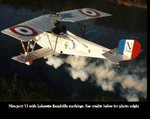cooltouch
Banned
I'm scanning a bunch of old slides right now, and have run across one that I took at an air show back in 1985, and I have no information on the airplane. I'd like to be able to include at least it's name and model number in the scan file.

I realize it isn't a WWII aircraft, but this is the forum that I feel I may have the best chances of getting this aircraft identified. From the general design, it appears to be from the same era as the Stearman, but it doesn't look like any Stearman I've seen. I'm assuming it's a trainer, but I've had no luck so far searching the net for a match. Judging from its markings, I'm guessing it's American.
Thanks for any help you can provide.
Michael

I realize it isn't a WWII aircraft, but this is the forum that I feel I may have the best chances of getting this aircraft identified. From the general design, it appears to be from the same era as the Stearman, but it doesn't look like any Stearman I've seen. I'm assuming it's a trainer, but I've had no luck so far searching the net for a match. Judging from its markings, I'm guessing it's American.
Thanks for any help you can provide.
Michael


